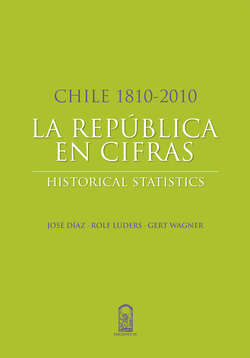Читать книгу Chile 1810-2010: La República en cifras - Jose Luis huertas Diaz - Страница 19
The selected period
ОглавлениеThroughout the two centuries starting in 1810 the country underwent changes and transformations of various kinds, keeping fundamental traits that evolved only slowly. Therefore, to finish this compilation in 2010 seems an appropriate time, not only because it is an important anniversary, the end of two centuries since Independence, but also because from then on much of the series can easily be updated by those who require such records. Once you have obtained some of the patience of a good navigator, it will be possible to make contact with the pages and publications of the agencies that produce statistics, thus incorporating indicators for subsequent years. This notwithstanding the fact that this is a dynamic context, surely evolving, so that the possibility of changes and innovations in the presentation of figures by producers of basic statistics may require some additional effort to achieve continuity with the indicators included in this publication.
At the other end, the starting of the compilation in 1810 is a more complex choice, but as we hope to show, not entirely arbitrary. Starting date coincides with today’s view, symbolically at least, that it is the beginning of the process that eventually culminated in the Republic of Chile. Although in many important aspects the new organizational form maintained previous institutions, there is good reason to believe that 1810 marks a significant break with regard to the construction of indicators to describe the country’s development capacity. Conflicts, expropriations and other phenomena implicit in the change of power from a colonial structure towards that of a republican organization, translated into difficulties and adjustments for production in the territory, in addition to fiscal financing limitations that often accompany transitions such as the one mentioned. Moreover, the explicit and formal trade liberalization adopted early as well as the tax base that is associated to it, probably drove changes and generated various stimuli, opening new opportunities and, as it is worth mentioning here, new challenges in construction of basic statistics.
Authors have estimated that the adjustment process associated with the full independence cycle, expressed in terms of production, took approximately 20 years and according to their best guess in the early 1830s the country regained per capita income of 1810 (Díaz, Lüders and Wagner 2007). This, then, is a second argument for our starting date: 1810 corresponds to the last year before the beginning of an extensive process of economic and socio-political changes of all kinds that are associated with new statistical challenges. A third argument in favor of using 1810 as the starting date of the compilation is related to the availability of basic material for setting such indicators.
A corollary of the previous discussion is that the definition of a starting date is convenient, while recognizing that the arguments given do not point strictly to 1810. However they emphasize that in this general context, around 1810 there seems to be a need to innovate in the search for basic data for the construction of development series. Finally, the choice of starting date does not mean that all series begin with 1810 –rather few of them actually do– and in this sense the starting year is simply a reference.
